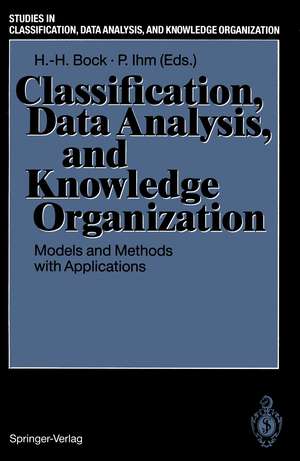Classification, Data Analysis, and Knowledge Organization: Models and Methods with Applications: Studies in Classification, Data Analysis, and Knowledge Organization
Editat de Hans-Hermann Bock, Peter Ihmen Limba Engleză Paperback – 5 feb 1991
Din seria Studies in Classification, Data Analysis, and Knowledge Organization
- 20%
 Preț: 754.09 lei
Preț: 754.09 lei - 20%
 Preț: 1203.30 lei
Preț: 1203.30 lei -
 Preț: 389.49 lei
Preț: 389.49 lei - 20%
 Preț: 587.28 lei
Preț: 587.28 lei - 18%
 Preț: 886.26 lei
Preț: 886.26 lei - 15%
 Preț: 654.43 lei
Preț: 654.43 lei - 18%
 Preț: 973.69 lei
Preț: 973.69 lei - 18%
 Preț: 1017.26 lei
Preț: 1017.26 lei -
 Preț: 417.41 lei
Preț: 417.41 lei - 18%
 Preț: 1113.09 lei
Preț: 1113.09 lei - 15%
 Preț: 645.14 lei
Preț: 645.14 lei - 15%
 Preț: 660.04 lei
Preț: 660.04 lei - 20%
 Preț: 583.37 lei
Preț: 583.37 lei - 15%
 Preț: 637.59 lei
Preț: 637.59 lei -
 Preț: 406.05 lei
Preț: 406.05 lei - 20%
 Preț: 997.38 lei
Preț: 997.38 lei - 18%
 Preț: 958.07 lei
Preț: 958.07 lei - 18%
 Preț: 954.45 lei
Preț: 954.45 lei - 18%
 Preț: 784.13 lei
Preț: 784.13 lei - 20%
 Preț: 999.53 lei
Preț: 999.53 lei - 18%
 Preț: 1391.52 lei
Preț: 1391.52 lei - 15%
 Preț: 657.25 lei
Preț: 657.25 lei - 18%
 Preț: 964.10 lei
Preț: 964.10 lei - 18%
 Preț: 962.35 lei
Preț: 962.35 lei - 15%
 Preț: 649.71 lei
Preț: 649.71 lei - 20%
 Preț: 1013.06 lei
Preț: 1013.06 lei - 15%
 Preț: 652.81 lei
Preț: 652.81 lei - 15%
 Preț: 647.73 lei
Preț: 647.73 lei - 20%
 Preț: 585.29 lei
Preț: 585.29 lei - 24%
 Preț: 795.77 lei
Preț: 795.77 lei - 20%
 Preț: 1464.66 lei
Preț: 1464.66 lei - 20%
 Preț: 559.43 lei
Preț: 559.43 lei - 15%
 Preț: 647.59 lei
Preț: 647.59 lei - 15%
 Preț: 650.04 lei
Preț: 650.04 lei - 15%
 Preț: 647.73 lei
Preț: 647.73 lei - 20%
 Preț: 572.08 lei
Preț: 572.08 lei - 15%
 Preț: 639.59 lei
Preț: 639.59 lei - 15%
 Preț: 683.40 lei
Preț: 683.40 lei - 15%
 Preț: 695.01 lei
Preț: 695.01 lei -
 Preț: 423.34 lei
Preț: 423.34 lei - 18%
 Preț: 945.30 lei
Preț: 945.30 lei - 15%
 Preț: 652.64 lei
Preț: 652.64 lei -
 Preț: 391.40 lei
Preț: 391.40 lei - 20%
 Preț: 561.11 lei
Preț: 561.11 lei - 20%
 Preț: 1002.67 lei
Preț: 1002.67 lei - 15%
 Preț: 640.37 lei
Preț: 640.37 lei - 20%
 Preț: 996.88 lei
Preț: 996.88 lei - 20%
 Preț: 1007.46 lei
Preț: 1007.46 lei - 15%
 Preț: 646.11 lei
Preț: 646.11 lei
Preț: 398.15 lei
Nou
Puncte Express: 597
Preț estimativ în valută:
76.19€ • 79.75$ • 63.41£
76.19€ • 79.75$ • 63.41£
Carte tipărită la comandă
Livrare economică 31 martie-14 aprilie
Preluare comenzi: 021 569.72.76
Specificații
ISBN-13: 9783540534839
ISBN-10: 3540534830
Pagini: 412
Ilustrații: XIII, 394 p.
Dimensiuni: 170 x 244 x 22 mm
Greutate: 0.65 kg
Ediția:Softcover reprint of the original 1st ed. 1991
Editura: Springer Berlin, Heidelberg
Colecția Springer
Seria Studies in Classification, Data Analysis, and Knowledge Organization
Locul publicării:Berlin, Heidelberg, Germany
ISBN-10: 3540534830
Pagini: 412
Ilustrații: XIII, 394 p.
Dimensiuni: 170 x 244 x 22 mm
Greutate: 0.65 kg
Ediția:Softcover reprint of the original 1st ed. 1991
Editura: Springer Berlin, Heidelberg
Colecția Springer
Seria Studies in Classification, Data Analysis, and Knowledge Organization
Locul publicării:Berlin, Heidelberg, Germany
Public țintă
ResearchCuprins
I: Mathematical and statistical methods for classification and data analysis.- Classification and clustering methods.- An agglomerative method for two-mode hierarchical clustering.- Selection from overlapping classifications.- On cluster methods for qualitative data II.- A regression analytic modification of Ward’s method: A contribution to the relation between cluster analysis and factor analysis.- The “partition with a structure” concept in biological data analysis.- Classification with neural networks.- Statistical and probabilistic aspects of clustering and classifications.- Multigraphs for the uncovering and testing of structures.- Estimators and relative efficiencies in models of overlapping samples.- Lower bounds for the tail probabilities of the scan statistic.- Poisson approximations of image processes in computer tomography.- Statistical, geometrical and algebraic methods for data analysis.- Some recent developments in linear models: A short survey (plenary lecture).- Causal analysis in marketing research with LISREL or a combination of traditional multivariate methods?.- Analysis of data measured on a lattice.- Dual algorithms in multidimensional scaling.- Comparison of biplot analysis and formal concept analysis in the case of a repertory grid.- Convexity in ordinal data.- Classification and seriation by iterative reordering of a data matrix.- Data analysis based on a conceptual file.- II: Knowledge organization, data bases, and information retrieval.- Modelling, representation and organization of conceptual knowledge.- Decentralized modelling of data and relationships in enterprises.- A contribution to the examination of semantic relations between lexemes.- A mathematical model for conceptual knowledge systems.- Compositional semantics and conceptrepresentation 163.- Data bases, expert systems, information retrieval, and library systems.- Small and beautiful? Some remarks on evaluating microcomputer based library systems.- A tool for validating PROLOG programs.- On the database component in the knowledge-based system WIMDAS.- Information retrieval techniques in rule-based expert systems.- Object databases and thesauri for small museums (plenary lecture).- Terminology and classification.- The structure and role of specialized information in scientific and technical terminologies.- Terminology work in the World Health Organization: EUROTERM abbreviations.- HyperTerm — A proposal for a user-friendly termbank.- The role of classification in terminology documentation (plenary lecture).- III: Applications and methods for special subject fields.- Classification, systematics, and evolution in biology.- The hierarchy of organisms: Systematics and classification in biology (plenary lecture).- Estimating phylogenies with invariant functions of data (plenary lecture).- Statistical analysis of genetic distance data.- Variance estimation in the additive tree model.- Classification and documentation in medicine.- Semi-automated classification of medical phrases using a personal computer.- Structure of informations on medical trials.- Recent problems and longterm activities in the classification of medical concepts.- Exploring three-dimensional image data with classification methods.- Data analysis in the archeological and historical sciences.- The reconstruction of “genetic kinship” in prehistoric burial complexes — Problems and statistics.- An approach to a formal statistical analysis of historical data based on the town of Bamberg.- Automatic syntax analysis of meroitic funeral inscriptions.- Application ofcomputers in historical-topographical research: A database for travel reports on Greece (18th and 19th century).- The use of multivariate statistics in Scandinavian archeology.- The application of correspondence analysis: some examples in archeology.- An analysis of beads found in the Merovingian cemetery of Weingarten.- Classification in industry: Coding systems and commodity description.- Bank code numbers as defining arguments and controlling tools in automated payments.- From commodity description to expert systems.- Tabular layouts of article characteristics and formal concept analysis (in German).- The postcode, a local and routing code for the transport of mail items.







